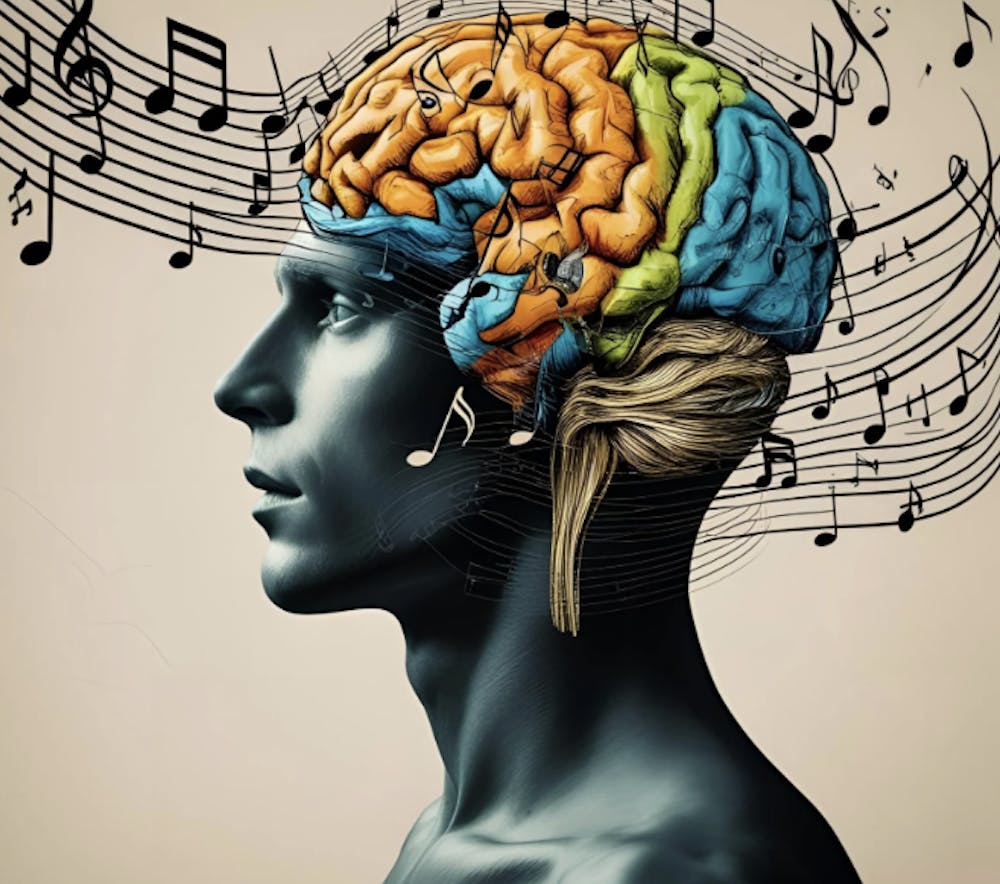“Where words fail, music speaks” is just one interpretation of many attempting to depict the profound effect of music. This quote from Hans Christian Andersen speaks clearly to the power and significance that music carries for people, culture, and society. From the beginning of our evolution as a species to the present day, music has accompanied humans as a form of creative expression, emotional comfort, and neurological adventure. But why is music this powerful? And how does it affect our brain?
In today's world, music is one of the most common activities that people take part in. Whether it’s listening on a morning commute, attending an arena concert, or performing in a school orchestra, there are countless times and places that people engage with music on a day-to-day basis. With the modern advent of phones and headphones, which provide instant access to an enormous range of musical content, listening has only gotten more accessible as the decades have passed. But the effect music has on the brain has been mostly the same from the start.
Though most commonly believed to only affect the right side of the brain, music has recently been discovered to light up multiple areas of the brain interconnectedly. The brain’s left side is the more logical, thinking side, while the right involves more creative processes. Thus, it would make sense for the connection to be mainly on the right side, but surprisingly it is not. From the frontal lobe to the amygdala to the hypothalamus, nearly every section of the brain is impacted by music. The frontal lobe, for instance, which controls the functioning of our decision making and logical processing, is greatly enhanced by listening to music, and even more so by playing it. Similarly, the hypothalamus, known for keeping the body’s nervous and endocrine systems connected and working together, is affected by the intake of music in that it can help reduce heart rate or blood pressure. These are just a couple of the areas of the brain that are most heavily influenced. Others include the amygdala, which processes and triggers emotions, and the hippocampus, which creates and retrieves memories.
However, one of the most fascinating elements of music is that even though we have been listening to it for as long as time, it is not something that humans are adapted to. Even in the modern day, music can provide a lot of activity for our brains, and stimulate various emotional and neurological responses. But music is something that is central to our species, and has been for quite some time. “Humanity’s relationship with music goes all the way back to our earliest days,” says Paul Rand on the Big Brains Podcast, a production from UChicago. “Our brains have evolved alongside this magical feature of reality, and it turns out that music may be doing more to and for our brains than we ever realized.”
In his podcast interview with Larry Sherman, a professor of neuroscience, Rand discusses some of the benefits and challenges that music can provide. One perplexing benefit was how listening to sad music can be a positive experience. Why would someone want to listen to sad music when they’re sad? Why not happy music? Listening to sad music can give a sense of catharsis to human sadness in a temporal fashion. We can experience emotional pain without feeling isolated, as we know there are people who have felt similar before. Music makes this clear and the stimulation it brings to the brain makes it an inviting activity to engage in, even when feeling depressed.
Another one of the substantial impacts that music has is the ways that playing an instrument positively stimulates the brain. In his podcast, Rand asks Sherman about the effects that playing an instrument has on the brain, to which Sherman responds “...playing an instrument is probably one of the most challenging things a human brain can do…it can drive a lot of different processes, one of which is myelination…one is neurogenesis, the creation of new neurons, and one is synapse formation.”
There are many different processes that take place when learning an instrument or practicing music, even down to the minute neuroscientific level. Myelination, as Sherman mentions, is the process that happens to help axons (central part of neurons) transmit signals throughout the brain more effectively. The two remaining processes that Sherman mentions are neurogenesis and synapse formation, both of which are incredibly important for general brain adaptability, plasticity, and cognitive functionality. All this goes to say that music, specifically playing it, has immense benefits for the brain.
Furthermore, a theory called the Mozart Effect was developed after the mid 90s, when a psychologist named Frances Rauscher studied how college students performed on a spatial reasoning test after listening to classical music—specifically Mozart. What he found was the students who listened to the music before the test had better results. Was this a coincidence? Possibly. After Rauscher’s initial curiosity with this dilemma, others performed similar experiments to see if this result was simply luck. Most of them came to the conclusion that listening to Mozart was not directly correlated with test taking. However, this can be explained by the generalization of Rauscher’s original experiment to apply to numerous types of tests. This was not the case; Rauscher only tested people with a spatial reasoning exam afterward. However the case still stands, since although music might not be directly linked with overall intelligence, it certainly impacts and drives the brain's ability to perform better on certain tests, such as those with logical and spatial reasoning. This is a critical point, as music can impact the brain's cognitive functions, not solely emotional processing.
One of the most interesting, profound components of music though is the connection between our ancestral roots of natural instinct towards rhythm, and the present day resemblance that music has in our culture and society. “If it is a language, music is a language of feeling. Musical rhythms are life rhythms, and music with tensions, resolutions, crescendos and diminuendos, major and minor keys, delays and silent interludes…” says an article from PubMed Central (Trimble & Hesdorffer, 2017). The rhythms that we have and appreciation for motion and emotion in music are essential to our species and culture. Our evolutionary adaptations have led us to appreciate and use music throughout our existence. For example, the mammalian ear is attuned to the human voice but evolved from other reptilian jaw bone structures that only carry sound at certain frequencies. In addition to this, humans’ visual cortex is smaller than other primates, making for more space in the auditory cortices among other related complexes of the brain (the prefrontal and premotor cortices). Most importantly, the ear, unlike other parts of the body, is always open to noise, and thus sound cannot be easily averted from people’s recognition.
Music and rhythm are a central part of our anatomy, even from birth. “From the rhythmic beating within and with the mother’s body for the fetus and young infant, to the primitive drum-like beating of sticks on wood and hand clapping of our adolescent and adult proto-speaking ancestors, the growing infant is surrounded by and responds to rhythm.” says the PMC article. Not only is music a commonplace activity and coping mechanism for many, but is pivotally centered in our evolution as a species. There are also ongoing theories about music and human speech being adapted from a proto-language, one that was Neanderthalic and stemmed from primate calls and shouts. This evolutionary view on the ways in which music has been crucial to humanity stretches beyond the everyday perspective we tend to manifest with music. The sounds of the world, the human voice, these are the primary methods through which our primal ancestors experienced music. Today, we have turned those noises into endless variations of organized sound and life, of music. By doing this we continue the ongoing story of humanity’s creative genius, our desire to reach beyond the realm of physical being, and to embody the world of spontaneity, growth, and spirit.
Music is rooted in our universal culture, a language that connects all. It is a language of feeling, of moving, of expressing the inexpressible. It’s one of crossing boundaries, fostering connections and changing people, and hence the world. “Music is God’s gift to man,” says Walter Savage Landor, “the only art of Heaven given to earth, the only art of earth we take to Heaven.” From our ancient ancestral cries and banging of sticks on the ground to stadiums full of earthshaking, ecstatic people, music strikes the human mind, body and spirit in a way indescribable through words. As Victor Hugo put it, “Music expresses that which cannot be said and on which it is impossible to be silent.”
Unlocking the Science of Music on Society and Culture

Source: Canva



